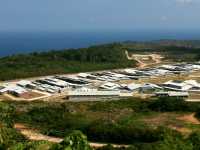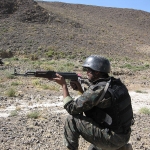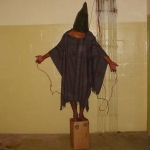Nightmare on Christmas Island: Serco's Australian Detention Center

Christmas Island Immigration Detention Centre PHOTO DIAC images
Some 1,600 miles from the West Coast of Australia; Christmas Island sits alone, surrounded by the Indian Ocean. The cliff-bound territory, with some 1,400 residents on just over 50 square miles, hosts a detention center where thousands of immigrants who tried to enter Australia illegally are indefinitely detained. The policy of intercepting and holding without charge asylum seekers --including more than 1,000 children--has sparked political debate in Australia. But Serco, the UK company contracted to manage the center, has largely escaped scrutiny.
"[Serco's] failure to perform is huge," says Kaye Bernard, an organizer with the Christmas Island Workers Union. Bernard meets regularly with workers from the Christmas Island Immigration Detention Centre (IDC). This year, several centers have teetered on the brink of chaos on numerous occasions, with riots at the Christmas Island and the Villawood IDC located in New South Wales. Unable to deal with the situation, Serco has called in the Australian Federal Police force, which has fired tear gas and rubber bullets at protesting detainees. Various human and refugee rights groups have accused Serco guards of brutality including beating prisoners.
The nine major IDCs within the Australian Immigration Detention Network include the Christmas Island facility, as well as at the Curtin, Scherger, Villawood, Marybirnong IDCs, scattered around mainland Australia. Immigration detention costs have risen to more than $1 billion in the past two years, according to Liberal Party shadow immigration spokesperson Scott Morrison. The Department of Immigration and Citizenship (DIAC), estimated that there were 6,872 detainees in immigration detention on April 15, 2011, with 1,102 in detention for more than 12 months. As of August 16, the centers held 5,622 detainees.
Most of the people seeking asylum in Australia are from Afghanistan, Iran, Iraq or Sri Lanka. As of April 15, some 2,258 Afghan, including Hazara who fled persecution by the Taliban, comprised the largest detainee population.
The average time in detention fluctuates between 280 days and 300 days, and "the longer people stay in detention, the worse their mental health," says head of Suicide Prevention Australia, Dr Michael Dudley. His assessment is confirmed in a report commissioned by the Australian government, in which the Detention Health Advisory Group (DeHAG) established a direct correlation between time in immigration detention and mental health problems: "[H]igh rates of major depression, anxiety and trauma," it noted, are exacerbated by time spent in detention.
"There's one man who's dug himself a six-foot grave in B2 compound and he's been sleeping there day and night," says Bernard.
SERCO
A FTSE 1000 international service company, Serco has grown largely through the outsourcing of public services, particularly from successive UK governments. Now worth an estimated $4 billion, Serco is involved in hospitals, traffic management, prisons, immigration detention, military logistics, military health support, prisoner transport and custodial security, education, health and justice, amongst other activities.
The Serco Group has operations throughout Europe, Asia, North America and Africa. More than 90 percent its revenue is derived from government contracts or franchises awarded by governments.
According to a Serco spokesperson: "Serco's experiences go beyond immigration detention centres and prisons, and it is this wider knowledge of public sector management that is utilised to maintain a high level of service to customers and clients."
The company has numerous operations in Australia, having recently won contracts to manage Fiona Stanley Hospital and the Acacia Prison, as well as deals to provide court security and custodial services in Western Australia, provide logistical support to the Australian Defence Force in Afghanistan, and manage the Borallon Correctional Facility in Queensland. The extent of Serco's involvement in Australia's military is underscored by the fact that Serco maintains a presence in every military base in Australia.
Privatizing Detention
Privatizing immigration detention, by removing "direct ministerial control over the daily operation of detention centers, not only allows governments to distance themselves from practices that might be condemned as abusive, but also has a deadening effect on public discussion," Dr. Michael Grewcock of the University of New South Wales told the Sydney Morning Herald.
The privatisation of Australia's immigration detention had a troubled history even before Serco's arrival. Australasian Correctional Management and G4S were awarded contracts, in 1997 and 2003 respectively, to manage the country's immigration detention centers, and both private companies attracted strong criticism.
Then, in 2009, the federal government awarded Serco a $367 million contract (since increased to $756 million) to manage Australia's Immigration detention centers.
For Serco, the detention center deal "demonstrates our ability to successfully leverage our world-leading home affairs capabilities to further broaden our presence in Australia," said Serco CEO Christopher Hyman in a media release announcing the 2009 contract win.
The conduct of the British company was controversial from the start. Serco has been fined for breaches of contract for every month that it has managed IDCs in Australia, according to Bernard. In March, The Australian reported that Serco had been fined a total of $4 million in early 2011. "We cannot detail breaches, fines imposed or other issues related to Serco's contract as they are considered commercial-in-confidence," a spokesperson for the Department of Immigration and Citizenship told CorpWatch.
Indeed, the contract itself is confidential and Serco would not provide details even to the Joint Select Committee on Australia's Immigration Detention Network, which has been established by Federal Parliament to investigate the management of Australia's immigration detention network.
Australian Politics
As elsewhere in the world, Australian politicians have won votes by appealing to nativist and racist sentiments. As recently as 1966, Australian immigration was governed by the highly controversial "White Australia Policy," the first piece of legislation passed by the Australian Federal Parliament, which restricted non-Caucasian immigration to Australia. Although this policy was abandoned, anti-immigrant sentiment continued. In 1992 the federal government under Labor Prime Minister Paul Keating introduced mandatory detention for all asylum seekers arriving in Australia without prior authorization.
Temporary facilities on Christmas Island were first established in late 2001, but the issue exploded during the 2001 Federal election. Labor opposition leader Kim Beazley was favored to defeat incumbent Prime Minister John Howard of the Liberal Party until a sinking fishing boat heaving at the seams with 438 asylum seekers (predominantly from Afghanistan) was rescued by the MS Tampa, a Norwegian tanker. The Australian government's refusal to allow the ship's captain to bring the asylum seekers to Christmas Island sparked a major maritime crisis.
Since then, both major parties have "been able to demonize asylum seekers by appealing to baseless fears," says Australian Greens senator Sarah Hanson-Young who was part of a group that visited the facilities in September.
Trailing significantly in the polls, Howard appealed to anti-immigrant sentiments: "We will decide who comes into this country, and the circumstances in which they come," he said. This hard-line assertion, which was often greeted with rapturous applause, became his catch phrase and was widely credited for helping swing the election in his favor. In the 2010 election campaign, Liberal Party leader Tony Abbott also campaigned on the simplistic promise that he would "stop the boats."
This year, with the issue of immigration spiralling out of control, Labor Prime Minister Julia Gillard reached an agreement with Malaysia to accept 800 asylum seekers intercepted in Australia waters. After the Australian High Court scuppered the plan, the Gillard government proposed a bill to revise immigration laws and legitimate the agreement. Then in a humiliating about face, Gillard announced on October 13 that she was killing the refugees swap plan and would process asylum seekers on Australian soil.
So for now, immigrants and refugees continue to be diverted Christmas Island, which became an Australian territory in 1957 after Canberra paid Singapore £2.9 million in compensation for lost revenues from phosphate mining.
Mental Health Problems, Poorly Trained Staff
The remote centers run by Serco are chronically overcrowded and understaffed, and access to mental and physical health care is limited, Christmas Island Workers Union's Bernard charges. Although Serco maintains some medical staffing, many problems require more specialized attention. Even at the Curtin detention center in mainland Western Australia, an ambulance trip to the nearest hospital takes 45 minutes, and except for a few days a month, there are no psychiatrists on site, with most assessments performed by phone.
Many detainees have experienced serious physical and mental health problems. From January to June of this year, 1,507 detainees were hospitalized, while on Christmas Island alone, there were 620 self-harm incidents, including suicide attempts. Since October 2010, five people have committed suicide in immigration detention centers in Australia, while "there have been many near misses," says Dudley, chair of Suicide Prevention Australia.
And the problem appears to be worsening. "In the first week of June when I visited Christmas Island, more than 30 incidents of self harm by detainees held there were reported," Australian Ombudsman, Allan Asher, who is currently investigating this matter, told ABC radio program AM.
Serco acknowledges the escalating problem, but blames the detainees for "creating a culture of self harm," and using it as "bargaining tool," according a May 31 memo issued by Serco management to staff, and leaked to The Australian.
Dudley disagrees, charging that Serco staffers "have no particular mental health skills to address the needs of detainees, and [they] operate from a prison model." Serco exacerbates the problem when, "self harming asylum seekers -- possibly victims of torture and trauma -- are put in solitary confinement," said Dudley.
Dudley also worries about the impact on workers. "I greatly doubt that there is any meaningful level of support to individual staff in often morally ambiguous situations, and suspect that morale for many staff, who are often very young, would be low."
After a recent wave of attempted suicides, staffers "were just in tears," laments Bernard. One young guard attended six code-blue self-harm incidents in a four hour period. Another, Kieran Webb, worked at the remote Curtin IDC for 6 months, where one of his charges, a 19-years-old Afghan man, Mohammad Atay, committed suicide on March 28. A few months later, while on holiday with his family, Webb, also 19, killed himself.
"These young 20-somethings with no training, no experience, are just thrown out there with no support," says Bernard. "One minute they are driving a forklift in a warehouse, the next they are in charge of a compound of 100 to 200 men."
On October 10, The Australian reported that Serco is also using subcontractors to recruit staff. "An English backpacker on a tourist visa, Australians straight from high school, and overseas students are among hundreds of casual workers earning up to $450 a day as "officers" in immigration detention centres.
"[They] hold licences to act as security officers including a level II in Security Operations. Regular checks are undertaken to verify this is the case," a Serco spokesman told The Australian.
Certificate II in Security Operations takes five to 10 days to complete, industry wide. But, according to a Serco spokesman, staffers attend four weeks of training before assuming their positions. In May, the ABC program Lateline, interviewed an anonymous Christmas Island IDC guard, who described the amount of training as, "to put it bluntly, stuff all." He said that staffing rosters contained names of non-existent guards. "They're not on the island, but they are on the roster."
A month earlier a Villawood IDC guard had told ABC that "Serco got rid of the training course, using staffing levels as an excuse and basically threw the staff on the floor." A Serco spokesman denies this charge, noting that the company has invested "more than $1.5 million in training Serco Immigration Services employees," providing "programs that meet, and in some cases exceed, the obligations outlined in its contract with DIAC."
"It is unacceptable," says Hanson-Young, "that Serco staff lack proper qualifications for dealing with people who have been traumatised, let alone vulnerable children."
Understaffing is also a perennial problem, says Hanson-Young. The company "does not maintain any staff to detainee ratios because it's not in the company's contract with Serco," she said citing the joint committee report.
The Christmas Island center was "typically 15 staff members short per day," former manager of the IDC Ray Wiley wrote to senior Serco management in October 2010. Such chronic understaffing "debilitates the worker to the extent that many have developed post-traumatic stress disorder," says Bernard.
According to Bernard, Serco staffers at Christmas Island told her "how scared they were, and how they had not had any training." In fact, Serco has subcontracted part of the staffing to MSS Security, said Steven Karras, acting DIAC regional manager at the Christmas Island IDC, and he is "not aware of any mental health awareness training" for MSS staff.
Serco refutes the claim that their staff do not undergo mental health training. "Mental health awareness and suicide awareness training" is part of the initial four week training program says a company spokesperson, who asked not to be named.
Claims of understaffing were also "incorrect and show little understanding of the staffing required at each site," said the spokesperson. Company staffing models consider a "wide range of factors, making it a far more complex determination that simply a staff to client ratio."
Citing the isolation of centers such as Christmas Island and the often short-term notice for replacements, staff numbers were not always ideal, he said, and there are "increased risks at some sites."
Overcrowding and Overwork
Limited qualifications and lack of training contribute not only to staff burn-out and trauma, but to detainee unrest. In March 2011, riots at Christmas Island pushed staff to the breaking point. "When all the riots were happening, staff worked 21 days straight, working up to 18 hours per day," says Bernard. "There was one staff member who was literally falling over from exhaustion, and we told them to go home. One of the senior managers from Serco turned up at their home and told them to get back to work." Such treatment "poses a threat to life for both the worker and detainees," says Bernard.
Detainee overcrowding magnifies the problems. In the first half of 2011, Christmas Island was over capacity on 28 occasions, according to documents released by DIAC to the inquiry of the joint select committee. In 2010, 144 detainees were being kept in classrooms, 92 in storerooms, 30 in a visiting area, and 240 in tents where they were supervised by a sole officer, according to former IDC manger Wiley.
Crowding was so serious that the visitor center at Christmas Island was converted to accommodate detainees on suicide watch, Karras told a hearing of the joint select committee which met on September 6 on Christmas Island. But the day before the committee arrived, Serco tried to mask the actual usage of this space by relocating the at-risk detainees and removing their beds from the visitor center, according to Bernard.
At the same hearing, Bernard told the committee that when staffers complain, incident reports to Serco can end up in Bin 13, aka the paper shredder. A Serco spokesperson counters that "all major incidents are reported directly to DIAC."
But Comcare, the government agency responsible for workplace safety confirms "under-reporting of notifiable incidents." And since Serco reports on itself, says Bernard, "there is an incentive not to report incidents that may incur a fine, while there is an incentive for the government to hide the truth," since unrest in detention centers provides the opposition with political fodder. Furthermore, the confidentiality agreements that all staff members are expected to sign, "are used as part of a fear and intimidation management practice to stop workers from reporting serious incidents and speaking out on OHS issues," says Bernard.
With the failure of the Gillard government's plans for transferring detainees to Malaysia, the focus will return to onshore processing of asylum seekers. But it is unlikely that Australia will move away from the growing trend of privatization.
Serco CEO Christopher Hyman describes the change from government's traditional role as one of provider of services to a 'procurer of services." These "new ways to fundamentally transform the efficiency and productivity of essential services," he says, "will result in a broadening of opportunities in existing markets, and the continued development of new markets, both in the UK and overseas." Kaye Bernard puts it differently: "Serco is making a killing."



